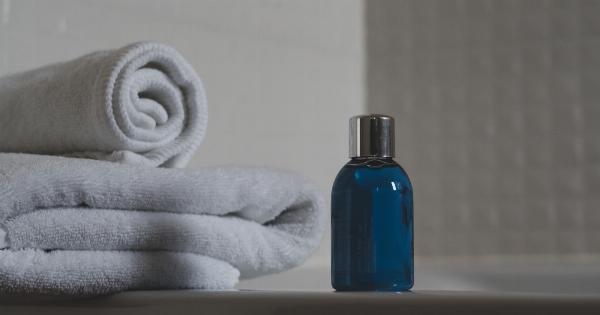When it comes to personal hygiene, one of the most debated topics is how often adults should take a bath or shower. While some people swear by daily showers, others argue that less frequent bathing is better for the skin and overall health.
So, what is the optimal bathing frequency for adults? Let’s explore this question in detail.
The importance of personal hygiene
Before delving into the specifics of bathing frequency, it is essential to understand the significance of personal hygiene. Maintaining proper hygiene habits is crucial for overall well-being.
Regular bathing helps remove dirt, sweat, and dead skin cells from the body, preventing the buildup of bacteria that can cause unpleasant odors and skin infections.
In addition to cleansing the body, bathing also has mental and emotional benefits. Taking a relaxing bath or shower can promote relaxation, reduce stress, and enhance overall mood.
It is also an opportunity for self-care and a break from the daily hustle and bustle.
Daily bathing: Is it necessary?
For many years, the prevailing belief was that daily bathing was essential for cleanliness. However, recent studies and expert opinions have challenged this notion.
While daily bathing is undoubtedly a personal preference for some individuals, it may not be necessary for everyone.
The frequency of bathing should be determined by various factors, such as individual body odor, skin type, climate, and personal activities.
For example, individuals who engage in physically demanding work or exercise regularly may feel the need to shower every day to remove sweat and odor. On the other hand, those with dry or sensitive skin may find that frequent bathing exacerbates skin issues or causes excessive drying.
Factors to consider
When deciding how often to bathe, it is important to consider the following factors:.
1. Body Odor
Body odor varies from person to person. Some individuals naturally produce more sweat and have stronger body odor than others. Those with a stronger natural scent may prefer to bathe more frequently to ensure they feel fresh and comfortable.
However, excessive washing can strip the skin of its natural oils, leading to dryness and irritation.
2. Skin Type
The type of skin a person has can also affect bathing frequency. Individuals with oily skin may find it necessary to cleanse their skin more often to remove excess sebum and prevent clogged pores.
On the other hand, those with dry or sensitive skin may need to limit bathing to prevent further drying and irritation.
3. Climate
The climate plays a crucial role in determining bathing frequency. In hot and humid climates, regular showers can help prevent heat rashes and keep the body comfortable by removing sweat and grime.
Conversely, in colder and drier climates, frequent bathing may contribute to dry, itchy skin. It is important to strike a balance that works best for your skin in your specific climate.
4. Personal activities
The activities a person engages in on a daily basis can influence their bathing needs. If you have a sedentary lifestyle or spend most of your time indoors, you may not require daily bathing.
However, individuals who participate in activities that involve sweating, like sports or heavy physical labor, may need to bathe more frequently to maintain personal hygiene.
Recommended bathing frequency
Considering the various factors mentioned above, the recommended bathing frequency for adults can vary. In general, most dermatologists and experts recommend bathing every two to three days as a baseline for personal hygiene.
This allows the body to maintain its natural moisture balance without stripping away essential oils.
However, it is important to note that personal hygiene practices can differ based on cultural norms and personal preferences. Some individuals may still prefer daily showers or baths, while others may be comfortable with less frequent bathing.
Tips for maintaining optimal personal hygiene
Regardless of bathing frequency, there are several other factors to consider when it comes to maintaining optimal personal hygiene:.
1. Use mild soaps or cleansers
When bathing, it is advisable to use mild soaps or cleansers that are gentle on the skin. Harsh soaps can disrupt the skin’s natural pH balance and cause dryness or irritation.
Look for products that are hypoallergenic and free from harsh chemicals.
2. Pay attention to areas prone to odor and sweat
Even if you choose to bathe less frequently, it is important to pay special attention to areas that are prone to odor and sweat, such as the underarms, groin, and feet. Regularly washing these areas with water and mild soap can help control body odor.
3. Practice good oral hygiene
Personal hygiene extends beyond bathing. Maintaining good oral hygiene is essential for overall cleanliness. Brush your teeth at least twice a day, floss regularly, and consider using mouthwash to keep your breath fresh.
4. Change clothes regularly
Wearing clean clothes is another crucial aspect of personal hygiene. Change your clothes daily, especially underwear and socks, to prevent the buildup of sweat and bacteria.
Conclusion
In conclusion, the frequency of bathing for adults varies based on individual factors such as body odor, skin type, climate, and personal activities. Daily bathing is not necessary for everyone and may even contribute to skin issues in some cases.
Most experts recommend bathing every two to three days as a baseline for personal hygiene, while others may still prefer daily showers. Ultimately, finding a bathing routine that works best for your body and lifestyle is essential.































